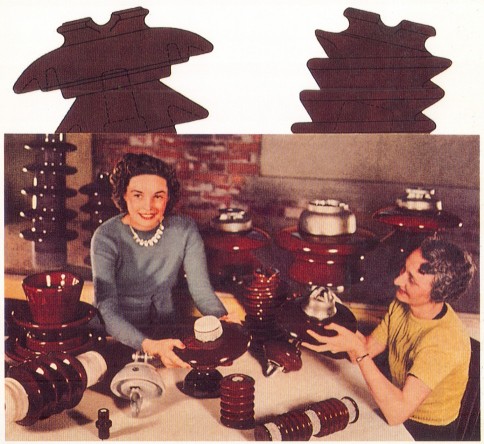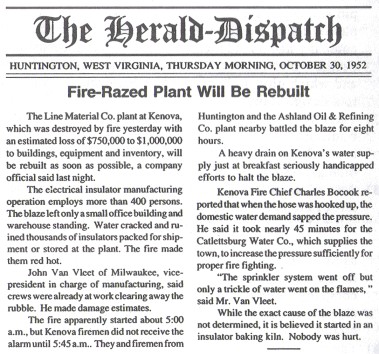Cover Me (J-D)
by Jimmie Burns
Reprinted from "Crown Jewels of the Wire", December 1997, page 3
This month's cover picture, from the August 1940 issue of The National Geographic
Magazine, paints a vivid portrait of the Jeffery-Dewitt Company. I
searched for this issue several years after Roger Lucas had found it and Carol
printed in black and white in Crown Jewels of the Wire. (December 1993, p. 24) I
was not aware that the original was in color and pleasantly surprised when I
found my copy in a Houston resale shop. I brought it to the August 1996 meeting
of the Lone Star Insulator Club meeting where it sparked Spencer Howard's
curiosity, who purchased his own copy and who is responsible for printing the
cover copy and submitting it to Crown Jewels of the Wire.


The picture was made
around the time that William (Bill) Stinson purchased the plant from Champion
Spark Plug Company. Stinson made changes to make the near bankrupt
Jeffery-Dewitt company profitable again. The cover picture illustrates the
changing Jeffery-Dewitt of this era.
1) Notice that the two young ladies are
holding standard pin and cap suspension insulators. By the time that
photographer Volkmar Wentzel snapped this picture the company had abandoned its
larger spider suspension design which Jeffery-Dewitt made its early reputation
on and which ultimately produced a high rate of failure due to a design flaw.
2)
There is only one "Bronco" style deadend glazed in the traditional JD
blue glaze. The ruddy chocolate glaze was becoming the standard glaze although I
have found JD blue glazes on insulators marked as late as 1945.
3) Also of
interest is the large multipart insulator in the far left of the picture. This
insulator has been unreported to this time although Bob Stahr believes that some
of these are in service in the Chicago area. Listed by Elton Gish as M-3380 it
apparently is a two piece giant produced by the casting method championed by the
Jeffery-Dewitt company. Again it must be noted that the large uniparts
characteristic of early JD production are missing from this picture.
4) The most
exciting discovery in this picture is the U-819 helical insulator. In the black and white picture which appeared in
Crown Jewels of the Wire, the insulator is so dark that it is indistinguishable.
This was an experimental design that was researched by both Jeffery-Dewitt and
Lapp. Although one Lapp porcelain post insulator using the helical design has
been found, no Jeffery-Dewitt product has been located, although several squatty
U-820 spirals have been found. Both the U-8l9 and the U-820 were intended to
reduce contamination, but more cost effective methods were found that made these
designs unprofitable. It is very gratifying that it can be affirmed that
Jeffery-Dewitt actually manufactured the helical design.
In conclusion, the picture also shows an odd assortment of bushings, small
pin types, deadends, and large substation insulators. The gleaming steel caps
are refreshing as compared to the discolored caps that collectors find when
these are taken out of service. Moreover, this picture demonstrates the new
Stinson regime that made the company profitable again and led to a lucrative
buyout by the Line Materials Company in 1950 which continued to produce
insulators using the JD logo until the fire that destroyed the plant at Kenova,
West Virginia in 1952.

| 